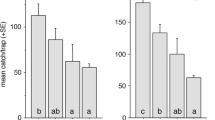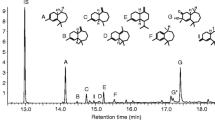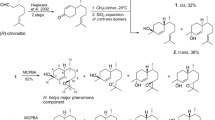Abstract
The semiochemicals verbenone (Vn), ipsenol (Ie), and ipsdienol (Id), present in late phases of host colonization, have been implicated as qualitative “shut-off” signals regulating attack density. Combinations of the three chemicals were released in pipe traps together with the aggregation pheromone components 2-methyl-3-buten-2-ol (MB) andcis-verbenol (cV) at different levels and in different ratios to MB + cV, and with two spacings of traps to test for possible effects on reducing catch at traps baited with aggregation pheromone. When they were released with the attractants Vn and Ie (alone or together) decreased the mean catch significantly at the higher release rates used (1 mg/day). Id alone or together with Vn at low release rates (0.1 mg/day), with the attractants, increased catch somewhat. A dose-response test of Vn, with the attractants held constant, showed a decline in catches, down to about < 10% of the control, at ratios of Vn to cV between 1∶1 and 150∶ 1. A larger spacing (25 m) of traps gave a stronger response to change in doses of Vn and MB + cV than a smaller (6 m) spacing. The sex ratio was more skewed towards females when two or three inhibitors were present and at higher doses of Vn. It is suggested that Vn could be the most important density-regulating signal in the natural system, as release of Vn from galleries is larger and starts earlier than that of Id and Ie.
Similar content being viewed by others
References
Anderbrant, O., Schlyter, F., andBirgersson, G. 1985. Intraspecific competition affecting parents and offspring in the bark beetleIps typographus.Oikos 45:89–98.
Anderbrant, O., Schlyter, F., andLöfqvist, J. 1988. Dynamics of tree-attack in the bark beetleIps typographus under semi-epidemic conditions, pp. 35–52,in T.L. Payne and H. Saarenmaa (eds.). Integrated Control of Scolytid Bark Beetles. Proceedings of IUFRO Working Party on Bark Beetles Symposia, Vancouver, July 3–10, 1988, Virgina Tech Press, Blacksburg, Virginia.
Bakke, A. 1975. Aggregation pheromone in the bark beetle,Ips duplicatus (Sahlberg).Norw. J. Entomol. 22:67–69.
Bakke, A. 1976. Spruce bark beetle,Ips typographus: Pheromone production and field response to synthetic pheromones.Naturwissenschaften 63:92.
Bakke, A. 1978. Aggregation pheromone components of the bark beetle,Ips acuminatus.Oikos 31:184–188.
Cbakke, A. 1981. Inhibition of the response inIps typographus to the aggregation pheromone; field evaluation of verbenone and ipsenol.Z. Angew. Entomol. 92:172–177.
Bakke, A., andKvamme, T. 1981. Kairomone response ofThanasimus predators to pheromone components ofIps typographus.J. Chem. Ecol. 7:305–312.
Bakke, A., andRiege, L. 1982. The pheromone of the spruce bark beetleIps typographus and its potential use in the suppression of beetle populations, pp. 3–15,in A.F. Kydonieus, and M. Beroza (eds.). Insect Suppression with Controlled Release Pheromone Systems, Vol. II. CRC Press, Boca Raton, Florida.
Bakke, A., Frøyen, P. andSkattebøl, L. 1977. Field response to a new pheromonal compound isolated fromIps typographus.Naturwissenschaften 64:98–99.
Bakke, A., Saether, T., andKvamme, T. 1983. Mass trapping of the spruce bark beetleIps typographus. Pheromone and trap technology.Medd. Nor. Inst. Skogforsk. 38(3): 1–35.
Bedard, W.D., Tilden, P.E., Lindhal, K.Q., Wood, D.L., andRauch, P.A. 1980. Effects of verbenone andtrans-verbenol on the response ofDendroctonus brevicomis.J. Chem. Ecol. 6:997–1013.
Birch, M.C., Light, D.M., andMori, K. 1977. Selective inhibition of response ofIps pini by the (S)-(−)-enantiomer of ipsenol.Nature 270:738–739.
Birch, M.C., Light, D.M., Wood, D.L., andSilverstein, R.M. 1980. Pheromone attraction and allomonal interruption ofIps pini in California by the two enantiomers of ipsdienol.J. Chem. Ecol. 6:703–717.
Birgersson, G., andBergström, G. 1989. Volatiles released from individual bark beetle holes: Quantitative variations during the first week of an attack.J. Chem. Ecol. 15:In press.
Birgersson, G., Schlyter, F., Löfqvist, J., andBergström, G. 1984. Quantitative variation of pheromone components in the spruce bark beetleIps typographus from different attack phases.J. Chem. Ecol. 10:1029–1055.
Birgersson, G., Schlyter, F., Bergström, G., andLöfqvist, J. 1988. Individual variation in aggregation pheromone content of the bark beetle,Ips typographus.J. Chem. Ecol. 14:1735–1759.
Borden, J.H., Hunt, D.W.A., Miller, D.A., andSlessor, K.N. 1986. Orientation in forest Coleoptera: An uncertain outcome of responses by individual beetles to variable stimuli, pp. 97–109,in T.L. Payne, M.C. Birch, and C.E.J. Kennedy (eds.). Mechanisms in Insect Olfaction. Oxford University Press, Oxford.
Botterweg, P.F. 1983. The effect of attack density on size, fat content and emergence of the spruce bark beetleIps typographus (L.).Z. Angew. Entomol. 96:47–55.
Byers, J.A. 1981. Effect of mating on terminating aggregation during host colonization in the bark beetle,Ips paraconfusus.J. Chem. Ecol. 7:1135–1147.
Byers, J.A. 1983. Sex specific responses to aggregation pheromone: Regulation of colonization density in the bark beetleIps paraconfusus.J. Chem. Ecol. 9:129–142.
Byers, J.A., andWood, D.L. 1980. Interspecific inhibition of the response of the bark beetles,Dendroctonus brevicomis andI. paraconfusus, to their pheromones in the field.J. Chem. Ecol. 6:149–164.
Byers, J.A., Anderbrant, O., andLöfqvist, J. 1989. Effective attraction radius as a method for comparing species attractants and determining densities of flying insects.J. Chem. Ecol. 15:749–765.
Dickens, J.C. 1981. Behavioral and electrophysiological responses of the bark beetle,Ips typographus, to potential pheromone components.Physiol. Entomol. 6:251–261.
Francke, W., Sauerwein, P., Vité, J.P., andKlimetzek, D. 1980. The pheromone bouquet ofIps amitinus.Naturwissenschaften 67:147–148.
Giesen, H., Kohnle, U., Vité, J.P., Pan, M.-L., andFrancke, W. 1984. Das Aggregation-spheromone des mediterranen KiefernborkenkäfersIps (Orthotomicus) erosus.Z. Angew. Entomol. 98:95–97.
Jones, D., andMatloff, N. 1986. Statistical hypothesis testing in biology: A contradiction in terms.J. Econ. Entomol. 79:1156–1160.
Leufvén, A. andBirgersson, G. 1987. Quantitative variation of different monoterpenes around galleries ofIps typographus (Coleoptera: Scolytidae) attacking Norway spruce.Can. J. Bot. 65:1038–1044.
Leufvén, A., Bergström, G., andFalsen, E. 1984. Interconversion of verbenols and verbenone by identified yeasts isolated from the spruce bark beetleIps typographus.J. Chem. Ecol. 10:1349–1361.
Leufvén, A., Bergström, G., andFalsen, E. 1989. Oxygenated monoterpenes produced by yeasts, isolated fromIps typographus (Coleoptera: Scolytidae) and grown in a phloem medium.J. Chem. Ecol. 14:353–362.
Lindström, M., Norin, T., Birgersson, G., andSchlyter, F. 1989. Variation of enantiomeric composition of α-pinene in Norway spruce,Picea abies, and its influence on the production of verbenol isomers byIps typographus in the field.J. Chem. Ecol. 15:541–548.
Livingston, W.H., Bedard, W.D., Mangini, A.C., andKinzer, H.G. 1983. Verbenone interrupts attraction of roundheaded pine beetleDendroctonus adjunctus (Coleoptera: Scolytidae) to sources of its natural attractant.J. Econ. Entomol. 76:1041–1043.
Mills, N.C. 1986. A preliminary analysis of the dynamics of within tree populations ofIps typographus (L.) (Coleoptera: Scolytidae).J. Appl. Entomol. 102:402–416.
Ogibin, B.N. 1973. Sex ratio and size of beetles of young generation with respect to different population density on fertility inIps typographus L.Zoo/. Zh. 52:1417–1419 (in Russian with English summary).
Payne, T.L., Coster, J.E., Richerson, J.V., Edson, L.J., andHart, E.R. 1978. Field response of the southern pine beetle to behavioral chemicals.Environ. Entomol. 7:578–582.
Perry, J.N. 1986. Multiple-comparison procedures: A dissenting view.J. Econ. Entomol. 79:1149–1155.
Postner, M. 1974. Scolytidae, Borkenkäfer, pp. 334–482,in W. Schwenke (ed.). Die Forstschädlinge Europas, 2. Paul Parey, Hamburg.
Regnander, J., andSolbreck, C. 1981. Effectiveness of different types of pheromone traps used againstIps typographus (L.) (Col., Scolytidae) in Sweden.Anz. Schaedlingskde. Pflantz. Umweltschutz. 54:104–108.
Ryker, L.C., andYandell, K.L. 1983. Effect of verbenone on aggregation ofDendroctonus ponderosae Hopkins (Coleoptera: Scolytidae) to synthetic attractant.Z. Angew. Entomol. 96:452–459.
Schlyter, F., andAnderbrant, O. 1989. Mass-attack of trees inIps typographus induced by sex-specific pheromone—a model of attack dynamics.Holarct. Ecol. In press.
Schlyter, F., andLöfqvist, J. 1986. Response of walking spruce bark beetlesIps typographus (L.) to natural pheromone from different attack phases.Entomol. Exp. Appl. 41:219–230.
Schlyter, F., Birgersson, G., Byers, J.A., Löfqvist, J. andBergström, G. 1987a. Field response of spruce bark beetle,Ips typographus to aggregation pheromone candidates.J. Chem. Ecol. 13:701–716.
Schlyter, F., Löfqvist, J., andByers, J.A. 1987b. The behavioural sequence in attraction to pheromone sources in the bark beetleIps typographus.Physiol. Entomol. 12:185–196.
Schlyter, F., Byers, J.A., andLöfqvist, J. 1987c. Attraction to pheromone sources of different quantity, quality and spacing: density regulation mechanisms in bark beetleIps typographus.J. Chem. Ecol. 13:1503–1523.
Schlyter, F., Byers, J.A., Löfqvist, J., Leufvén, A., andBirgersson, G. 1989. Reduction of attack density of the bark beetlesIps typographus andTomicus piniperda on host bark by verbenone inhibition of attraction to pheromone and host kairomone, pp. 53–68,in T.L. Payne and H. Saarenmaa (eds.). Integrated Control of Scolytid Bark Beetles, Proceedings of IUFRO Working Party on Bark Beetles Symposia, Vancouver, July 3–10, 1988, Virginia Tech Press, Blacksburg, Virginia.
Stoakley, J.T., Bakke, A., Renwick, J.A.A., andVité, J.P. 1978. The aggregation pheromone system of the larch bark beetle,Ips cembrae Hear.Z. Angew. Entomol. 86:174–177.
Tilden, P.E., andBedard, W.D. 1988. Effect of verbenone on response ofDendroctonus brevicomis toexo—brevicomin, frontalin, and myrcene.J. Chem. Ecol, 14:113–122.
Thalenhorst, W. 1958. Grundzüge der Populationsdynamik des grossen FichtenborkenkäfersIps typographus L.Schriftenreihe Forstl. Fak. Univ. Göttingen 21:1–126.
Vité, J., Bakke, A., andRenwick, J. 1974. Ein Populationslockstoff der zwölfzähnigen KiefernborkenkäfersIps sexdentatus.Naturwissenschaften 61:365.
Vité, J.P., Billings, R.F., Ware, C.W., andMori, K. 1985. Southern pine beetle: Enhancement or inhibition of aggregation response mediated by enantiomers ofendo-brevicomin.Naturwissenschaften 72:99–100.
Wood, D. 1982. The role of pheromones, kairomones, and allomones in the host selection and colonization behavior of bark beetles.Ann. Rev. Entomol. 27:411–446.
Author information
Authors and Affiliations
Additional information
This study was made within the Swedish project “Odour signals for control of pest insects.”
Rights and permissions
About this article
Cite this article
Schlyter, F., Birgersson, G. & Leufvén, A. Inhibition of attraction to aggregation pheromone by verbenone and ipsenol. J Chem Ecol 15, 2263–2277 (1989). https://doi.org/10.1007/BF01014114
Received:
Accepted:
Issue Date:
DOI: https://doi.org/10.1007/BF01014114




